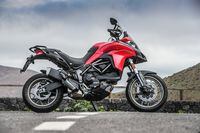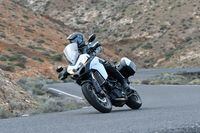The Multistrada 1200 has been a strong seller for Ducati, but the adventure-touring bike’s $17,999 base price is out of reach for many. So, Ducati decided to bring the Multistrada 950 to the lineup, using the same chassis, subframe, and swingarm as the 1200 Enduro , paired with the engine of the Hypermotard , SuperSport , and the soon-to-be-discontinued Hyperstrada. Ducati’s aim with the 950 was to make a more “accessible” Multistrada. A less extensive and less sophisticated electronics package, an LCD screen instead of a color display, and a manually adjustable fork (shared with the Desert Sled, but with stiffer spring rate), help knock $4,000 off the more expensive 1200′s price, putting the 950 within financial reach for more riders.
Firing up the Testastretta powerhouse gives a palpable yet somewhat tame (and familiar) snarl. The 937cc liquid-cooled V-twin pumps out a claimed 113 horsepower and 71 pound-feet of torque. Getting up to speed, vibrations start around 5,000 rpm, proving the 950 isn’t as long legged as its 1200 bigger brother. That doesn’t keep it from delivering plenty of power to get up to highway speeds and pass traffic in a swift manner. Carving through the serpentine bitumen I opted to keep the bike in third gear, and there was plenty of torque to pull through tighter turns.
Suspension on the Multistrada 950 was set to “comfort” from the factory, meaning the settings were at the soft end of the range. That meant the long-travel suspension did a good job of absorbing imperfections in the tarmac without transmitting much to the seat. (Speaking of which, the saddle was plenty comfortable for an all day ride, without the slightest hint of saddle soreness.) As mentioned before, the front suspension is shared with the new Ducati Desert Sled. Both front and rear suspension are fully (manually) adjustable (compared to the electronically adjustable Skyhook system of the Multi 1200 S), though I didn’t find it necessary to make any adjustments throughout the day. The softer suspension setting led to a noticeable amount of nose dive during an abrupt braking maneuver, but I suspect adjusting compression would have helped, though I’ll admit I was missing Skyhook.
Being only 5-foot-5 with a 30-inch inseam, I found the Multistrada’s seat height intimidating on paper, and challenging in real life. In contrast, my time in the 1200’s saddle (which was in the low setting), made slow speed maneuvers and stops less stressful. Accessory seats are available for the 950 that go as low as 32.3 inches and as high as 33.9 inches, but only stock seats were available for our test ride. I was just able to tippy toe both feet while seated, though I felt more comfortable when sitting off to the side of the seat, which let me place one foot firmly on the ground. Pushing the 500 lbs. (claimed, wet) bike off its sidestand required a fair amount of effort or momentum if it wasn’t parked on level ground. Once we got moving, though, the bike’s size and weight felt comfortable and manageable enough through most riding conditions.
The rider triangle is quite generous, same as the Multi 1200; there was plenty of room to stretch my legs, and not feel cramped with too tight a bend in my knees. The reach to the handlebars is a reasonable distance, even with my shorter torso. While the width of the handlebars provided good leverage for steering, the distance from grip to grip was more than I was comfortable with for a whole day’s ride. Like its big brother, the smaller Multi is still built for a rider larger than myself.
Turn-in was slower on the 950 than the 1200, due to a longer wheelbase that matches the Multistrada 1200 Enduro. A larger front wheel and shallower rake also keep the 950 from feeling as sporty as its big brother. This was especially apparent during tight U-turns, but the slower handling also made its presence known while cornering at speed. Presumably a design element to ease existing Multi-owners’ outspoken off-road anxiety, the larger front hoop supposedly raised the ground clearance a touch, but again, at the sacrifice of nimble steering feel. For those with actual off-road intentions, Ducati recommends the Enduro.
The Brembo brakes on the Multistrada 950 were a bit soft on initial bite, but grew progressively stronger with more lever pull. Three-setting ABS and an eight-setting TC system make up the Ducati Safety Pack. Additionally, the Multi 950 offers four preset ride modes (which adjust ABS and DTC along with throttle response): Urban, Touring, Sport, and Enduro. Switching from one mode to the next was not the most intuitive process, and took longer than it should. Touring and Urban modes gave a nice easy throttle response, while Sport mode certainly gave a more eager power output at wrist’s twist, without being as jumpy as the Multi 1200. Since our test route didn’t include dirt, I left the Enduro ride mode untouched. The Multistrada 1200 S has the same four ride modes, but has a higher level of sophistication in the electronics: suspension is adjusted with each ride mode, and throttle response is more immediate in Sport Mode because, well, the 1200 makes a lot more power.
At $13,995 the smaller of Ducati’s adventure touring category is a whopping four grand less than its bigger brother. With new, higher maintenance intervals (9,000 miles between oil changes, and 18,000 miles for valve clearances, same as the Multi 1200), there’s no doubting the great deal of value in the new Multistrada 950. Offered in Ducati Red, or Star White Silk for an additional $200, the new Multistrada will be available in spring of 2017.
When Ducati touted the Multistrada 950 as a more accessible bike, I wasn't just expecting a more financially feasible motorcycle, but something that would fit smaller riders like myself. Considering how many features are available on the 950, despite being a less sophisticated system than the 1200, the smaller Multi offers a lot of value for the money. Ducati made a step in the right direction, but could go one step further: A truly accessible Multistrada could still utilize the 937cc engine, but what about putting it in a smaller chassis? Shorter measurements from tip to tail, and shave a couple inches off the seat height would make this adventure tourer much more than financially accessible, but physically more approachable for the rider under 5-foot-7. As it stands, the only Ducati adventure bike that's reasonably sized for someone like me is the Scrambler. Other manufacturers are taking their smaller customers more seriously in the ADV and touring category, so why shouldn't Ducati? The 950's engine is tame enough to make a novice touring rider less intimidated than the 1200, while still enjoying a fun engine and comfortable setup. Ducati has the right idea with this bike, they just didn't go far enough. I hope to see that change in the future.
























/cloudfront-us-east-1.images.arcpublishing.com/octane/VZZXJQ6U3FESFPZCBVXKFSUG4A.jpg)
/cloudfront-us-east-1.images.arcpublishing.com/octane/QCZEPHQAMRHZPLHTDJBIJVWL3M.jpg)
/cloudfront-us-east-1.images.arcpublishing.com/octane/HXOUJXQWA5HBHGRO3EMJIGFMVI.jpg)

/cloudfront-us-east-1.images.arcpublishing.com/octane/3TIWWRV4JBBOLDVGRYECVVTA7Y.jpg)
/cloudfront-us-east-1.images.arcpublishing.com/octane/KIX5O23D5NAIBGFXBN3327DKZU.jpg)
/cloudfront-us-east-1.images.arcpublishing.com/octane/7GJYDUIPXRGMTMQKN6ONYOLBOU.jpg)
/cloudfront-us-east-1.images.arcpublishing.com/octane/MUQLOVLL2ZDGFH25ILABNBXKTI.jpg)
/cloudfront-us-east-1.images.arcpublishing.com/octane/TNOU5DNE2BC57MFPMGN2EIDXAM.jpg)
/cloudfront-us-east-1.images.arcpublishing.com/octane/GTCXACQGJ5HAPDTGWUQKDEH44E.jpg)
/cloudfront-us-east-1.images.arcpublishing.com/octane/S35YGSEMEZB4BLTDJTSZPF4GLA.jpg)
/cloudfront-us-east-1.images.arcpublishing.com/octane/5UOT6HPX2JFMRJAX6EH45AR4MQ.jpg)
/cloudfront-us-east-1.images.arcpublishing.com/octane/OKWOJWAKP5EP3OACCRRWPCIX2Q.jpg)
/cloudfront-us-east-1.images.arcpublishing.com/octane/2WF3SCE3NFBQXLDNJM7KMXA45E.jpg)
/cloudfront-us-east-1.images.arcpublishing.com/octane/G4MG6OUCJNBSHIS2MVVOTPX65E.jpg)
/cloudfront-us-east-1.images.arcpublishing.com/octane/IIGGWFOTOJGB7DB6DGBXCCMTDY.jpg)
/cloudfront-us-east-1.images.arcpublishing.com/octane/QSTCM6AVEZA5JJBUXNIQ3DSOF4.jpg)
/cloudfront-us-east-1.images.arcpublishing.com/octane/U4I7G625B5DMLF2DVIJDFZVV6M.jpg)
/cloudfront-us-east-1.images.arcpublishing.com/octane/B6XD6LS6IVCQPIU6HXDJSM3FHY.jpg)
/cloudfront-us-east-1.images.arcpublishing.com/octane/ICL63FEDDRDTTMINYICCEYGMDA.jpg)
/cloudfront-us-east-1.images.arcpublishing.com/octane/FCGZHQXRBZFLBAPC5SDIQLVF4I.jpg)
/cloudfront-us-east-1.images.arcpublishing.com/octane/WNOB6LDOIFFHJKPSVIWDYUGOPM.jpg)

/cloudfront-us-east-1.images.arcpublishing.com/octane/X33NU3E525ECRHXLNUJN2FTRKI.jpg)